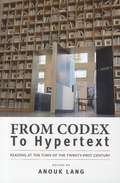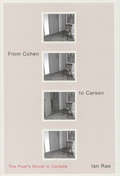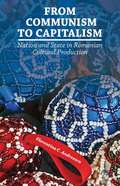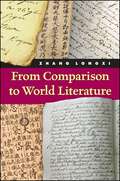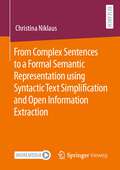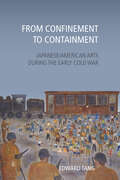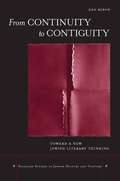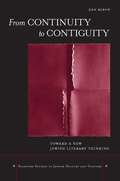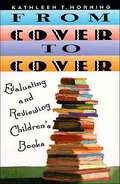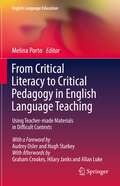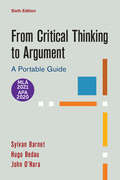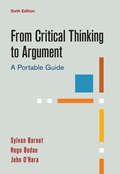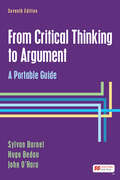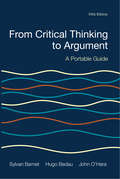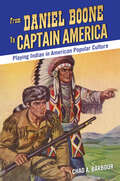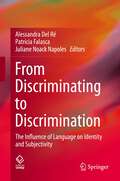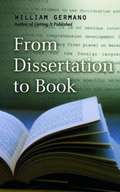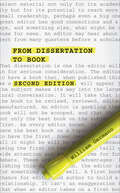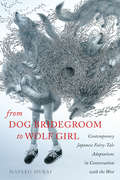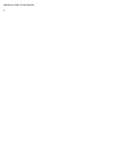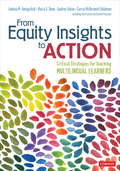- Table View
- List View
From Codex to Hypertext: Reading at the Turn of the Twenty-First Century
by Anouk LangThis volume includes essays that consider how changes such as the mounting ubiquity of digital technology and the globalization of structures of publication and book distribution are shaping the way readers participate in the encoding and decoding of textual meaning. Contributors also examine how and why reading communities cohere in a range of contexts, including prisons, book clubs, networks of zinesters, state-funded programs designed to promote active citizenship, and online spaces devoted to sharing one's tastes in books.
From Cohen to Carson
by Ian RaeDetailed case studies of novels by Leonard Cohen, Michael Ondaatje, George Bowering, Daphne Marlatt, and Anne Carson, as well as sections on A.M. Klein and Anne Michaels, reveal how these authors framed their early novels according to formal precedents established in their poetry. In tracking the authors' shift from lyric to long poem to novel, Rae also investigates their experiments with non-literary art forms - photography, painting, film. The authors discussed combine disparate genres and media to alter notions of narrative coherence in the novel and engage the diverse but fragmented cultural histories of Canadian society.
From Cohen to Carson: The Poet's Novel in Canada
by Ian RaeDetailed case studies of novels by Leonard Cohen, Michael Ondaatje, George Bowering, Daphne Marlatt, and Anne Carson, as well as sections on A.M. Klein and Anne Michaels, reveal how these authors framed their early novels according to formal precedents established in their poetry. In tracking the authors’ shift from lyric to long poem to novel, Rae also investigates their experiments with non-literary art forms - photography, painting, film. The authors discussed combine disparate genres and media to alter notions of narrative coherence in the novel and engage the diverse but fragmented cultural histories of Canadian society.
From Colonial to Modern: Transnational Girlhood in Canadian, Australian, and New Zealand Literature, 1840-1940
by Kristine Moruzi Michelle J. Smith Clare BradfordThrough a comparison of Canadian, Australian, and New Zealand texts published between 1840 and 1940, From Colonial to Modern develops a new history of colonial girlhoods revealing how girlhood in each of these emerging nations reflects a unique political, social, and cultural context. Print culture was central to the definition, and redefinition, of colonial girlhood during this period of rapid change. Models of girlhood are shared between settler colonies and contain many similar attitudes towards family, the natural world, education, employment, modernity, and race, yet, as the authors argue, these texts also reveal different attitudes that emerged out of distinct colonial experiences. Unlike the imperial model representing the British ideal, the transnational girl is an adaptation of British imperial femininity and holds, for example, a unique perception of Indigenous culture and imperialism. Drawing on fiction, girls’ magazines, and school magazine, the authors shine a light on neglected corners of the literary histories of these three nations and strengthen our knowledge of femininity in white settler colonies.
From Communism to Capitalism
by Florentina C. AndreescuThis book offers an interdisciplinary mode of analyzing transitions from communism and planned economy to democracy and capitalism focusing on how the various social and political transformations are reflected within one hundred Romanian films produced during communism, transition, and post-transition.
From Comparison to World Literature (SUNY series in Chinese Philosophy and Culture)
by Longxi ZhangThe study of world literature is on the rise. Until recently, the term "world literature" was a misnomer in comparative literature scholarship, which typically focused on Western literature in European languages. In an increasingly globalized era, this is beginning to change. In this collection of essays, Zhang Longxi discusses how we can transcend Eurocentrism or any other ethnocentrism and revisit the concept of world literature from a truly global perspective. Zhang considers literary works and critical insights from Chinese and other non-Western traditions, drawing on scholarship from a wide range of disciplines in the humanities, and integrating a variety of approaches and perspectives from both East and West. The rise of world literature emerges as an exciting new approach to literary studies as Zhang argues for the validity of cross-cultural understanding, particularly from the perspective of East-West comparative studies.
From Complex Sentences to a Formal Semantic Representation using Syntactic Text Simplification and Open Information Extraction
by Christina NiklausThis work presents a discourse-aware Text Simplification approach that splits and rephrases complex English sentences within the semantic context in which they occur. Based on a linguistically grounded transformation stage, complex sentences are transformed into shorter utterances with a simple canonical structure that can be easily analyzed by downstream applications. To avoid breaking down the input into a disjointed sequence of statements that is difficult to interpret, the author incorporates the semantic context between the split propositions in the form of hierarchical structures and semantic relationships, thus generating a novel representation of complex assertions that puts a semantic layer on top of the simplified sentences. In a second step, she leverages the semantic hierarchy of minimal propositions to improve the performance of Open IE frameworks. She shows that such systems benefit in two dimensions. First, the canonical structure of the simplified sentences facilitates the extraction of relational tuples, leading to an improved precision and recall of the extracted relations. Second, the semantic hierarchy can be leveraged to enrich the output of existing Open IE approaches with additional meta-information, resulting in a novel lightweight semantic representation for complex text data in the form of normalized and context-preserving relational tuples.
From Confinement to Containment: Japanese/American Arts during the Early Cold War (Asian American History & Cultu)
by Edward TangDuring the early part of the Cold War, Japan emerged as a model ally, and Japanese Americans were seen as a model minority. From Confinement to Containment examines the work of four Japanese and Japanese/American artists and writers during this period: the novelist Hanama Tasaki, the actor Yamaguchi Yoshiko, the painter Henry Sugimoto, and the children’s author Yoshiko Uchida. The backgrounds of the four figures reveal a mixing of nationalities, a borrowing of cultures, and a combination of domestic and overseas interests. Edward Tang shows how the film, art, and literature made by these artists revealed to the American public the linked processes of U.S. actions at home and abroad. Their work played into—but also challenged—the postwar rehabilitated images of Japan and Japanese Americans as it focused on the history of transpacific relations such as Japanese immigration to the United States, the Asia-Pacific War, U.S. and Japanese imperialism, and the wartime confinement of Japanese Americans. From Confinement to Containment shows the relationships between larger global forces as well as how the artists and writers responded to them in both critical and compromised ways.
From Continuity to Contiguity: Toward a New Jewish Literary Thinking
by Dan MironThis book offers original insights into modern Hebrew, Yiddish, and other Jewish literatures, including a new interpretation of Franz Kafka's place within them and discussions of Sholem Aleichem, Sh. Y. Abramovitsh, Akhad ha'am, M. Y. Berditshevsky, Kh. N. Bialik, and Y. L. Peretz.
From Continuity to Contiguity: Toward a New Jewish Literary Thinking
by Dan MironMiron (Hebrew and comparative literature, Columbia U.) brings extraordinary depth and breadth of thought to his work; he is the author of some than 30 volumes of literary scholarship and criticism in Hebrew, Yiddish, English, German, and Russian. He describes the present volume in a prologue as "... focusing on argument rather than offering solid proof, offering an ongoing narrative rather than being historically descriptive, being argumentative and conceptual rather than mimetic." He begins with discussion of the "old" Jewish literary discourse and the illusion of Israeli cultural normalcy. Subsequent chapters address modern Jewish literary thinking--the enlightenment and advent of nationalism and then proceed through time: the 19th & 20th centuries literary renaissance, the interbellum decades--Hebrew, and Yiddish issues; Franz Kafka, and his contiguity with Sholem Aleichem. The concluding chapter looks toward new and freshly illuminating discourse. Annotation ©2011 Book News, Inc., Portland, OR (booknews.com)
From Conversation to Oral Tradition: A Simplest Systematics for Oral Traditions (Routledge Studies in Rhetoric and Stylistics #10)
by Raymond F PersonThis book argues that many of the most prominent features of oral epic poetry in a number of traditions can best be understood as adaptations or stylizations of conversational language use, and advances the claim that if we can understand how conversation is structured, it will aid our understanding of oral traditions. In this study that carefully compares the "special grammar" of oral traditions to the "grammar" of everyday conversation as understood in the field of conversation analysis, Raymond Person demonstrates that traditional phraseology, including formulaic language, is an adaptation of practices in turn construction in conversation, such as sound-selection of words and prosody, and that thematic structures are adaptations of sequence organization in talk-in-interaction. From this he concludes that the "special grammar" of oral traditions can be understood as an example of institutional talk that exaggerates certain conversational practices for aesthetic purposes and that draws from cognitive resources found in everyday conversation. Person's research will be of interest to conversation analysts as well as literary scholars, especially those interested in ancient and medieval literature, the comparative study of oral traditions and folklore, and linguistic approaches to literature. This volume lays the groundwork for further interdisciplinary work bridging the fields of literature and linguistics.
From Cover to Cover: Evaluating and Reviewing Children's Book
by Kathleen T. Horning“[A] beautifully written how-to manual, which also manages to present a treatise on what is best in children’s literature and why. . . . An excellent resource.” —BooklistThis revised edition of From Cover to Cover offers a fresh, up-to-date look at some of the best examples of children’s literature and also includes practical advice on how to write clearly articulated, reasoned opinions so that others can learn about books they have not yet read.An updated introduction explains how children’s books evolve from manuscripts into bound books and the importance of the many different parts of a book (jacket flaps, title page, copyright, etc.) and changes in the children’s book industry, such as the creation of two new major genre awards. In addition, the author demonstrates how to think about and critically evaluate several different genres of children’s books.Included are sections about books of information; traditional literature (myths, legends, tall tales, folktales); poetry, verse, rhymes, and songs; picture books; easy readers and traditional books; and fiction and graphic novels. There is also a concluding chapter on how to write reviews that are both descriptive and analytical, including a segment on children’s literature blogs.Updated material includes:•Information on the many changes in the children’s book industry•A section on genres•A section on children’s literature blogs•An introduction of two new major genre awards: the Robert F. Sibert Informational Book Award and the Theodor Seuss Geisel Award•And more than 90% of the books cited have been updated from the first edition to more recent publications!“[A] very complete resource that will continue to be the venerable reference tool.” —School Library Journal“An excellent guide.” —ALA Booklist
From Critical Literacy to Critical Pedagogy in English Language Teaching: Using Teacher-made Materials in Difficult Contexts (English Language Education #23)
by Melina PortoWith a Foreword by Hugh Starkey and Audrey Osler, and Afterwords by Graham Crookes, Hilary Janks and Allan Luke, this book promotes critical language education and illustrates how a critical agenda can be enacted in English language education in real classrooms. It presents four cases located in primary and secondary schools in the province of Buenos Aires in Argentina in contexts that can be characterised as vulnerable or difficult. It describes the possibilities, challenges and limitations of this critical agenda using students’ drawings, posters, leaflets, artwork, classroom activities and conversational data as foundation, and including the voices of local teachers in their classrooms. Importantly, these teachers used teacher-made, locally produced, critical post-method materials, described by the author of those materials in one of the chapters. In this way, the book offers a unique balance of researcher, teacher and materials writer voices. These materials are included in the book and can help language teachers around the world to introduce critical perspectives in their specific contexts. The book is appealing to researchers, classroom teachers, teacher educators, and materials writers and developers interested in critical language education.
From Critical Thinking To Argument: A Portable Guide
by Sylvan Barnet Hugo BedauFrom Critical Thinking to Argument is a very brief but thorough guide to critical thinking and argument. With only fifteen readings, this affordable guide can stand alone or complement an anthology. Comprising a condensed version of the text portion of the widely adopted Current Issues and Enduring Questions, it draws on the authors’ dual expertise in effective persuasive writing and comprehensive rhetorical strategies to help students move from critical thinking to argumentative and researched writing. This versatile text features treatment of classic and modern approaches including Aristotelian, Toulmin, and Rogerian argument, as well as a new chapter on analyzing pop culture texts. Like other volumes in the Bedford/St Martin’s popular series of Portable Anthologies and Portable Guides, From Critical Thinking to Argument offers the series’ trademark combination of high quality and great value for teachers of writing and their cost-conscious students.
From Critical Thinking to Argument with 2020 APA and 2021 MLA Updates: A Portable Guide
by John O'Hara Sylvan Barnet Hugo BedauThis ebook has been updated to provide you with the latest guidance on documenting sources in MLA style and follows the guidelines set forth in the MLA Handbook, 9th edition (April 2021).From Critical Thinking to Argument is a brief but thorough guide to argument at a great value. This versatile text gives students strategies for critical thinking, reading, and writing and makes argument concepts clear through its treatment of classic and modern approaches to argument, including Aristotelian, Toulmin, and Rogerian argument, as well as visual rhetoric. For today’s increasingly visual learners who are challenged to separate what’s real from what’s not, new activities and visual flowcharts support information literacy, and an appendix of practical Sentence Guides helps students incorporate the moves of academic writers into their own arguments. With just eighteen readings, this affordable guide can stand alone or complement an anthology.
From Critical Thinking to Argument: A Portable Guide
by Barnet Badau O’HaraFrom Critical Thinking to Argument is a brief but thorough guide to argument at a great value. This versatile text gives students strategies for critical thinking, reading, and writing and makes argument concepts clear through its treatment of classic and modern approaches to argument, including Aristotelian, Toulmin, and Rogerian argument, as well as visual rhetoric. For today’s increasingly visual learners who are challenged to separate what’s real from what’s not, new activities and visual flowcharts support information literacy, and an appendix of practical Sentence Guides helps students incorporate the moves of academic writers into their own arguments. With just eighteen readings, this affordable guide can stand alone or complement an anthology.
From Critical Thinking to Argument: A Portable Guide
by John O'Hara Sylvan Barnet Hugo BedauThis versatile text gives students strategies for critical thinking, reading, and writing and makes argument concepts clear through its treatment of classic and modern approaches to argument.
From Critical Thinking to Argument: A Portable Guide, 5th Edition
by John O'Hara Sylvan Barnet Hugo BedauFrom Critical Thinking to Argument is a very brief but thorough guide to critical thinking and argument. With only fifteen readings, this affordable guide can stand alone or complement an anthology. Comprising a condensed version of the text portion of the widely adopted Current Issues and Enduring Questions, it draws on the authors' expertise in persuasive writing and logical thinking, and now with new co-author John O'Hara, an expanded focus on critical thinking. It helps students move from critical thinking to argument and research. This versatile text features treatment of classic and modern approaches including Aristotelian, Toulmin, and Rogerian argument, as well as an expanded chapter on visual rhetoric. Like other volumes in the Bedford/St. Martin's popular series of Portable Anthologies and Portable Guides, From Critical Thinking to Argument offers the series' trademark combination of high quality and great value for teachers of writing and their cost-conscious students.
From Daniel Boone to Captain America: Playing Indian in American Popular Culture
by Chad A. BarbourFrom nineteenth-century American art and literature to comic books of the twentieth century and afterwards, Chad A. Barbour examines in From Daniel Boone to Captain America the transmission of the ideals and myths of the frontier and playing Indian in American culture. In the nineteenth century, American art and literature developed images of the Indian and the frontiersman that exemplified ideals of heroism, bravery, and manhood, as well as embodying fears of betrayal, loss of civilization, and weakness.In the twentieth century, comic books, among other popular forms of media, would inherit these images. The Western genre of comic books participated fully in the common conventions, replicating and perpetuating the myths and ideals long associated with the frontier in the United States. A fascination with Native Americans also emerged in comic books devoted to depicting the Indian past of the US In such stories, the Indian remains a figure of the past, romanticized as a lost segment of US history, ignoring contemporary and actual Native peoples.Playing Indian occupies a definite subgenre of Western comics, especially during the postwar period when a host of comics featuring a "white Indian" as the hero were being published. Playing Indian migrates into superhero comics, a phenomenon that heightens and amplifies the notions of heroism, bravery, and manhood already attached to the white Indian trope. Instances of superheroes like Batman and Superman playing Indian correspond with depictions found in the strictly Western comics. The superhero as Indian returned in the twenty-first century via Captain America, attesting to the continuing power of this ideal and image.
From Discriminating to Discrimination: The Influence of Language on Identity and Subjectivity
by Juliane Noack Napoles Alessandra Del Ré Patrícia FalascaThis book adopts a multidisciplinary approach to try to answer the question of how do we, as human beings, go from the socially neutral linguistic act of discriminating external stimuli to the socially loaded act of promoting social discrimination though language? This contributed volume brings together works presented at the international event “From Discriminating to Discrimination – The Influence of Language on Identity and Subjectivity”. This was an online event hosted and organized by the Brandenburg University of Technology (BTU), Germany, in partnership with São Paulo State University (UNESP), Brazil, that brought together lecturers from different universities around the world. During the event, linguists, psychologists, language teachers, social workers and pedagogues got together to discuss how discriminating can be recognized as a natural and important ability of the human being in the early stages of life and, after that, how to avoid discriminatory acts against others. The debates held online took into account the important and necessary dialogue between linguistics and other social sciences to discuss the role played by language as a form of building subjectivity and teaching practices that can contribute to minimize discrimination and promote integration and acceptance in a broad sense, understanding the preponderant role of language in recognizing what is different (discriminating), without diminishing or excluding it (discrimination). From Discriminating to Discrimination: The Influence of Language on Identity and Subjectivity will help linguists, psychologists, educators, social workers and a broad range of social scientists working with cognitive, linguistic and educational studies understand the path taken by differentiation, from the beginning of the child's language development – when discrimination (of sounds, gestures, etc.) is essential for the acquisition of language to occur –, until the moment when differentiation, discrimination, ceases to be an essential factor and becomes a means of social segregation.
From Dissertation to Book
by William P. GermanoAll new Phd's hope that their dissertations can become books. But a dissertation is written for a committee and a book for the larger world. William Germano's From Dissertation to Book is the essential guide for academic writers who want to revise a doctoral thesis for publication. The author of Getting It Published, Germano draws upon his extensive experience in academic publishing to provide writers with a state-of-the-art view of how to turn a dissertation into a manuscript that publishers will notice. Acknowledging first that not all theses can become books, Germano shows how some dissertations might have a better life as one or more journal articles or as chapters in a newly conceived book. But even dissertations strong enough to be published as books first need to become book manuscripts, and at the heart of From Dissertation to Book is the idea that revising the dissertation is a fundamental process of adapting from one genre of writing to another. Germano offers clear guidance on how to do just this. Writers will find advice on such topics as rethinking the table of contents, taming runaway footnotes, shaping chapter length, and confronting the limitations of jargon, alongside helpful timetables for light or heavy revision. With crisp directives, engaging examples, and a sympathetic eye for the foibles of academic writing, From Dissertation to Book reveals to recent PhD's the process of careful and thoughtful revision- a truly invaluable skill as they grow into their new roles as professional writers.
From Dissertation to Book (Chicago Guides to Writing, Editing, and Publishing)
by William GermanoHow to transform a thesis into a publishable work that can engage audiences beyond the academic committee.When a dissertation crosses my desk, I usually want to grab it by its metaphorical lapels and give it a good shake. “You know something!” I would say if it could hear me. “Now tell it to us in language we can understand!”Since its publication in 2005, From Dissertation to Book has helped thousands of young academic authors get their books beyond the thesis committee and into the hands of interested publishers and general readers. Now revised and updated to reflect the evolution of scholarly publishing, this edition includes a new chapter arguing that the future of academic writing is in the hands of young scholars who must create work that meets the broader expectations of readers rather than the narrow requirements of academic committees.At the heart of From Dissertation to Book is the idea that revising the dissertation is fundamentally a process of shifting its focus from the concerns of a narrow audience—a committee or advisors—to those of a broader scholarly audience that wants writing to be both informative and engaging. William Germano offers clear guidance on how to do this, with advice on such topics as rethinking the table of contents, taming runaway footnotes, shaping chapter length, and confronting the limitations of jargon, alongside helpful timetables for light or heavy revision.Germano draws on his years of experience in both academia and publishing to show writers how to turn a dissertation into a book that an audience will actually enjoy, whether reading on a page or a screen. He also acknowledges that not all dissertations can or even should become books and explores other, often overlooked, options, such as turning them into journal articles or chapters in an edited work. With clear directions, engaging examples, and an eye for the idiosyncrasies of academic writing, he reveals to recent PhDs the secrets of careful and thoughtful revision—a skill that will be truly invaluable as they add “author” to their curriculum vitae.
From Dog Bridegroom to Wolf Girl: Contemporary Japanese Fairy-Tale Adaptations in Conversation with the West (Series in Fairy-Tale Studies)
by Mayako MuraiAs in the United States, fairy-tale characters, motifs, and patterns (many from the Western canon) have pervaded recent Japanese culture. Like their Western counterparts, these contemporary adaptations tend to have a more female-oriented perspective than traditional tales and feature female characters with independent spirits.In From Dog Bridegroom to Wolf Girl: Contemporary Japanese Fairy-Tale Adaptations in Conversation with the West, Mayako Murai examines the uses of fairy tales in the works of Japanese women writers and artists since the 1990s in the light of Euro-American feminist fairy-tale re-creation and scholarship. After giving a sketch of the history of the reception of European fairy tales in Japan since the late nineteenth century, Murai outlines the development of fairy-tale retellings and criticism in Japan since the 1970s. Chapters that follow examine the uses of fairy-tale intertexts in the works of four contemporary writers and artists that resist and disrupt the dominant fairy-tale discourses in both Japan and the West. Murai considers Tawada Yoko's reworking of the animal bride and bridegroom tale, Ogawa Yoko's feminist treatment of the Bluebeard story, Yanagi Miwa's visual restaging of familiar fairy-tale scenes, and Konoike Tomoko's visual representations of the motif of the girl's encounter with the wolf in the woods in different media and contexts. Forty illustrations round out Murai's criticism, showing how fairy tales have helped artists reconfigure oppositions between male and female, human and animal, and culture and nature. From Dog Bridegroom to Wolf Girl invites readers to trace the threads of the fairy-tale web with eyes that are both transcultural and culturally sensitive in order to unravel the intricate ways in which different traditions intersect and clash in today's globalising world. Fairy-tale scholars and readers interested in issues of literary and artistic adaptation will enjoy this volume.
From Elvish To Klingon: Exploring Invented Languages
by Michael AdamsFrom the Elvish language Tolkien invented for denizens of Middle Earth to the science fiction lingo spoken by the Klingons in Star Trek, writers have always endeavored to create new forms of expression, not only in the English language, but in languages that exist only in their own imaginations.
From Equity Insights to Action: Critical Strategies for Teaching Multilingual Learners
by Maria G. Dove Audrey F. Cohan Andrea Honigsfeld Carrie McDermott GoldmanYour Greatest Assets are Right Before Your Eyes: Your Multilingual Learners! Equity for multilingual learners (MLLs) means that students’ cultural and linguistic identities, backgrounds, and experiences are recognized as valued, rich sources of knowledge and their academic, linguistic, literacy, and social–emotional growth is ensured to the fullest potential. This ready-to-use guide offers practical, classroom-level strategies for educators seeking thoughtful, research-informed, and accessible information on how to champion equity for MLLs in a post-COVID era. Focused on the deliberate daily actions that all teachers of multilingual learners can take, this resource guide captures a compelling advocacy framework for culturally and linguistically responsive equity work, including Authentic examples of how educators understand and support MLLs through an equity lens Student portraits of multilingual learners’ experiences Accessible answers to essential how-to questions Robust professional learning activities Access to print and online resources for additional information Thoughtful probes throughout the guide help teachers develop student agency and foster pathways in their own practice and communication with multilingual learners.
